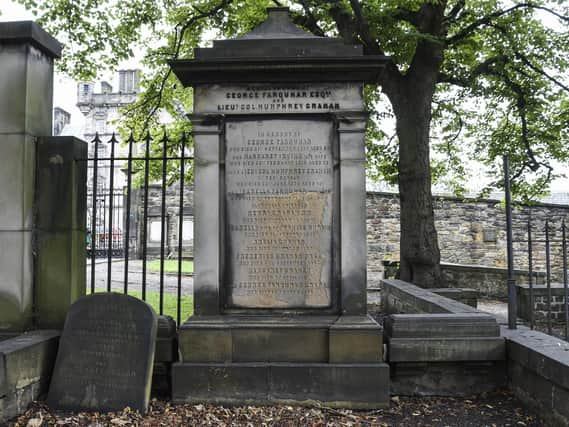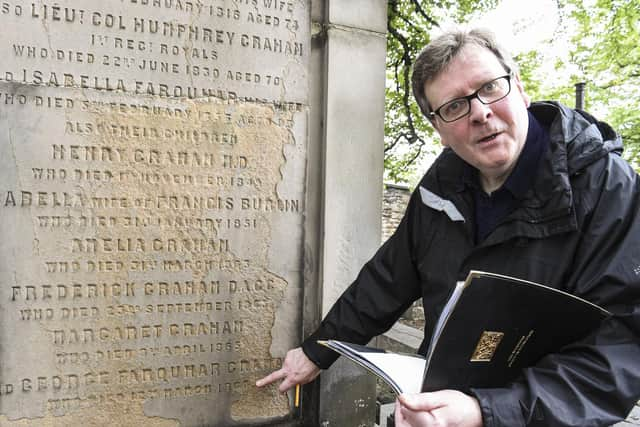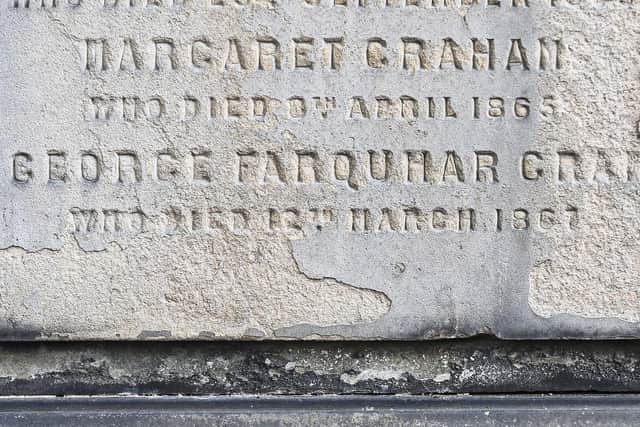Tombstone leads popular tour guide to Edinburgh's very first festival, 205 years ago


That name was George Farquhar Graham, a secretary of the first ever Edinburgh Musical Festival, in 1815.
“One hundred and thirty-two years before the Edinburgh International Festival was launched in 1947, Edinburgh was already a festival city,” says Robin Mitchell, historian and owner of Cadies and Witchery Tours, on West Bow.
Advertisement
Hide AdAdvertisement
Hide AdExplaining how he made the discovery, he continues, “As we come out of lockdown, I’ve been researching possible new walking tours that would accommodate the new government Covid guidance. Everyone has heard of Greyfriars’ Bobby and the Mackenzie Poltergeist, but what of the less-well known graves in the kirkyard? I decided to take a walk around and look at the names on the stones to see what stories they might hold.”


It was while doing this that one name in caught his attention, although it almost didn’t. At the very bottom of one stone on a family plot, the name George Farquhar Graham was almost worn away. Researching Graham, who lived between 1789 to 1867, Mitchell quickly realised there was timely story to be to be told.
He says, “I found that Graham, the last inscription on the stone, was the eldest son of Lieutenant Colonel Humphrey Graham.”
“And it was recorded that from an early age he had an aptitude for music and, as his folks were well-heeled, was able to devote his life to his great love.”
Advertisement
Hide AdAdvertisement
Hide AdMitchell discovered that in 1815, when just 26 years old, Graham was appointed as one of the secretaries of the first ever Edinburgh Musical Festival.


“The opening concert of that inaugural festival took place at Parliament House behind St Giles’ on the morning of 31st October 1815 - a programme of ‘popular music by Handel and Haydn’ was played,” he says. “An advert had been placed in the Edinburgh Evening Courant of the 26th October 1815 to tell citizens about their new festival and, apparently, an organ was brought from London and installed in Parliament Hall for the occasion. It had to be shipped into Leith and driven up to town from the docks. It took eight weeks to assemble.”
Though Parliament Hall was the focus of the festival, some concerts were also performed at the city’s long lost Corri’s Concert Rooms. “Corri’s Concert Rooms were at the top of Broughton Street,” reveals Mitchell, “They were named after a talented family of composers and musicians. Domenico Corri was at one point manager of the Theatre Royal, later part of the site of the GPO at Waterloo Place.”
For the third evening concert of the Edinburgh Music Festival, Graham composed an overture and the following year published a book entitled An Account of the First Edinburgh Musical Festival, which is still on sale. A huge success, that first Edinburgh festival shared more in common with today’s incarnation than you might imagine, says Mitchell.
Advertisement
Hide AdAdvertisement
Hide Ad“There were a number of comparisons with today’s festival. Concerts were oversubscribed and they had to organise extra performances to meet demand. There were parking restrictions, with no parking of horse drawn carriages near the venues, and tickets were very expensive - very, very expensive, which meant many ordinary folk were excluded.”
It wasn’t just the music that provided the entertainment either, another highlight had citizens looking skyward. As part of the festival, pioneering English aeronaut James Sadler flew his balloon over the city - he got as a far as Portobello.
Graham himself died at Gilmore Place on 12 March 1867, by which time he had also become a respected writer contributing to the likes of the Encyclopedia Britannica and The Scotsman.
Mitchell concludes, “I just find it fascinating that you have this great big tombstone and he is but an ‘and’ on the bottom, his name almost erased by time. It really is amazing what you find if you look beyond the headline act.”
A message from the Editor:
Advertisement
Hide AdAdvertisement
Hide AdThank you for reading this story on our website. While I have your attention, I also have an important request to make of you.
The dramatic events of 2020 are having a major impact on many of our advertisers - and consequently the revenue we receive. We are now more reliant than ever on you taking out a digital subscription to support our journalism.
Subscribe to the Edinburgh Evening News online and enjoy unlimited access to trusted, fact-checked news and sport from Edinburgh and the Lothians. Visit https://www.edinburghnews.scotsman.com/subscriptions now to sign up.
By supporting us, we are able to support you in providing trusted, fact-checked content for this website.
Joy Yates
Editorial Director